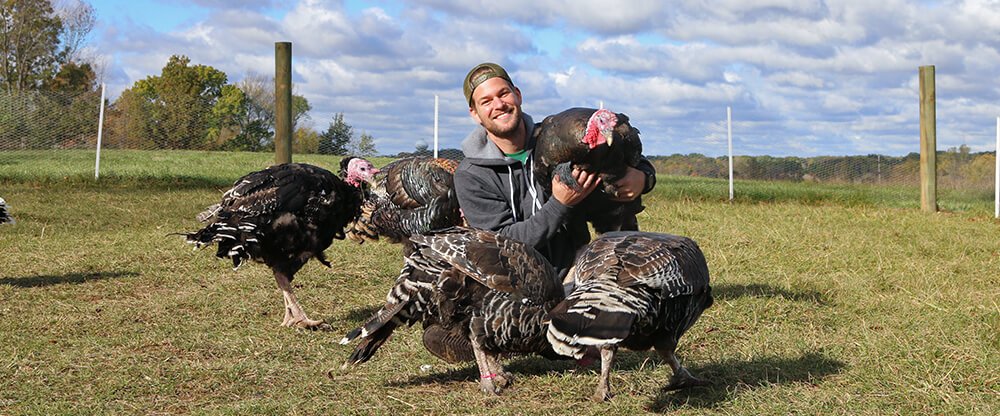Learn About Turkeys
Turkeys are incredibly interesting, social and affectionate birds. They form strong, lifelong familial bonds with each other and are very loyal. In the wild, turkeys enjoy scratching in the grass, roosting in trees, dust bathing and sharing communal meals. Given the opportunity, turkeys can live to between five and seven years old.
Mother turkeys are wonderfully nurturing and their chicks will often stay with them for five months, and in some cases up to a year. Mother hens will fight to protect their young and even sacrifice themselves to safeguard their chicks.
Turkeys have excellent memories and can learn the precise details of over 1,000 acres by exploring the area with their beaks. They also have distinct voices—just like humans do—and they can recognize the voices of their friends and family. They have over 20 different vocalizations that they use to communicate with each other. Turkeys actually even have regional dialects, so a turkey from here in Michigan will sound different than a turkey from Europe.
Only males make the traditional “gobble” sound that people most often associate with turkeys. They are also larger than the females and have a long piece of flesh above their beak, called a snood, that they extend and retract given their mood. The males, or toms, love to show off for attention. They puff up their beautiful iridescent feathers, extend their wings down and display their brightly colored heads and snoods. When they show off, they can be incredibly striking.
Given time and trust, the turkey residents at Barn Sanctuary will seek out the attention and affection of our staff and volunteers. They will climb into our laps and enjoy being petted so much that they begin purring, much like cats do.
Turkeys Used for Meat
Turkeys raised in the animal agricultural industry, however, do not get to engage in these normal turkey activities. Instead, they are raised as commodities and given little to no comforts in their traumatic and abbreviated lives.
Instead of living with their families and friends for their five to seven years, turkeys in this industry are sent to slaughter at just five to seven months of age. Over 300 million turkeys in the US alone are sent to slaughter every year. Nearly 50 million of those are for holidays like Thanksgiving and Christmas alone.
Image from Peta.org
Due to the increased mechanization of farming practices and the surge of industrialized factory farms, turkeys have been genetically modified and selectively bred to gain weight rapidly. In the 1970’s, turkeys weighed around 17 pounds when they were sent to slaughter. Today, turkeys at that age weigh 28 pounds on average. The results of these modifications are staggering.
Rapid weight gain that has been bred into these turkeys causes a multitude of health risks, including trauma to their internal organs, damage to their joints or limbs, and even broken legs. Their bodies are not designed to carry such heavy weight. In fact, male turkeys gain so much weight in their breasts that they can no longer mate naturally. Nearly all turkeys raised for food are the product of artificial insemination—a degrading and harmful practice for both males and females.
Turkeys raised in the animal agricultural industry are not raised on pastures with rolling green hills. Most are confined in large, windowless warehouses with tens of thousands of other birds. The conditions are filthy and stressful. The ammonia buildup in the air from waste, as well as overcrowding, create a breeding ground for disease and respiratory issues. However, since one factory worker may be responsible for handling sometimes 30,000 birds individually, these problems are frequently overlooked.
As a result of these stressful and unhealthy surroundings, the birds will often attack one another or pluck out their own feathers. Due to the “risk” this creates, handlers will slice off the beaks and the tips of their toes to minimize the damage they can do to each other. Males will also often have their snood cut off. These are incredibly painful procedures, and they cripple a turkey’s ability to be a turkey. Losing a beak or a snood is losing an essential aspect of a turkey’s life.
Image from Peta.org
After months of living in these squalid conditions, the turkeys are then transported to slaughterhouses. The process of collecting and caging the turkeys for transport is rough and often leads to injury or death as multiple turkeys are grabbed by their legs and stuffed tightly into cages and loaded onto trucks. Hundreds of thousands of turkeys die during the transport process annually; many succumb to the heat, the cold, dehydration, starvation and injury.
The remaining turkeys that make it are delivered to the slaughterhouse. Although The Humane Slaughter Act, or the Humane Methods of Livestock Slaughter Act (P.L. 85-765; 7 U.S.C. 1901 et seq.) was enacted in 1958, it does not include birds, which has been affirmed by the USDA. Therefore, turkeys are exempt from any protection provided by the Humane Slaughter Act.
Protecting Lives
Making the decision to avoid contributing to this industry goes a long way to protecting the lives of many unique individual turkeys. By not creating the demand, residents like Stanley and the Golden Girls have the opportunity to thrive and enjoy their lives as turkeys.



